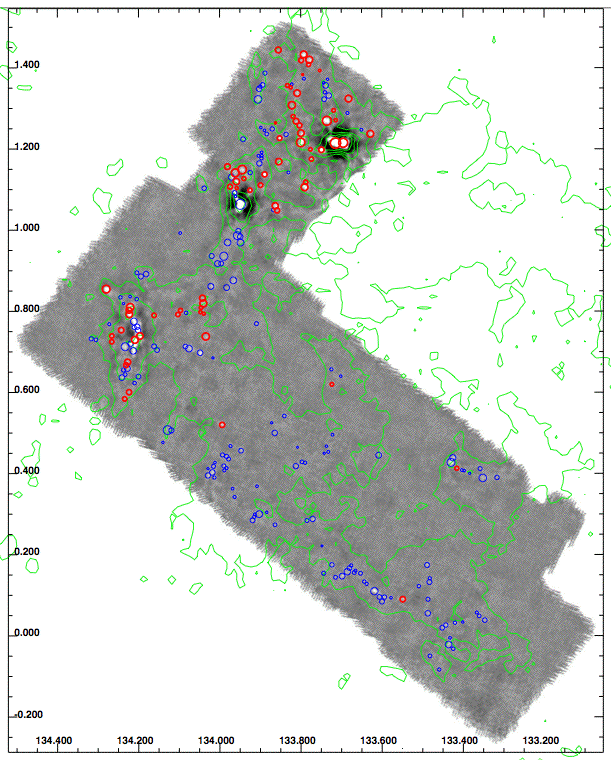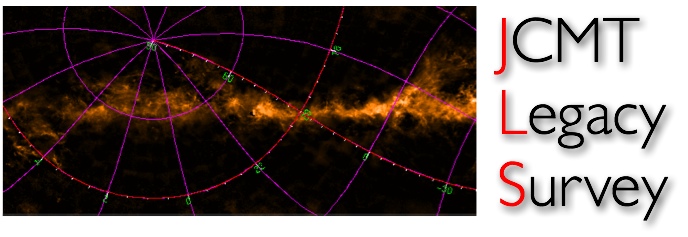JCMT Galactic Plane Survey
The basic science goal of the JPS is to achieve a full census of star-formation activity in the plane of the Galaxy observable from JCMT, to a detected mass limit of around 40 solar masses at the far edge of the Galaxy. Given this limit and the latitude range (equivalent to the scale height of OB stars at ~3kpc), the specific science goals are related to high-mass star formation and can be grouped under four main headings:
- An Evolutionary Sequence for high-mass SF: A complete sample of all embedded phases of high-mass young stellar objects, in comparison to existing (and planned) IR-selected samples, will allow a determination of a basic evolutionary sequence. In particular, the numbers and distribution of objects detected in the submm continuum but not in the IR will establish the length of the poorly understood earliest evolutionary phases and the extent to which triggering and clustering are necessary conditions for high-mass star formation.
- Triggering and the star-forming content of molecular clouds: Measurements of the potential star forming content of molecular clouds, in the form of dense and potentially bound structures will allow us to measure the natural variation of this ‘star-formation’ efficiency and of the mass function in dense cores in different environments. We will be able to quantify the effects of triggering interactions (compression due to OB star winds, expanding HII regions and SNe) on the production and mass distribution of dense structures, a first step towards a quantitative understanding of the effects of feedback on star formation. In addition, we will be able to test models of star formation in a turbulent environment.
- Cold Dark Clouds and the formation of molecular clouds: In order to understand star formation we need to determine the process that produces the molecular clouds in which stars form. Cold Dark Clouds (CDCs) contain both atomic and molecular gas and have densities and temperatures that bridge the gap between the ambient atomic ISM and cold, dense molecular clouds. Many have cold HI absorption without CO emission but structures similar to molecular clouds. CDCs may therefore be sites of formation of molecular clouds out of the turbulent neutral medium. SCUBA observations will provide estimates of total gas columns and hence constrain the atomic-to-molecular ratios in these objects. Using 450/850 ratios and the FTS data, the JPS will also show how dust properties, as manifested in the thermal balance and emissivity index in the submm continuum, vary between and within CDCs.
- Galactic Structure: The location of dense, star-forming structures relative to sites of recent high-mass star formation traced by HII regions (e.g. from the CORNISH VLA survey), OB clusters traced by UKIDSS and Spitzer, and the far-IR traced Massive Young Stellar Objects will show the relationship between two or three generations of high-mass SF yielding a structural picture of star formation in the Galaxy, how it relates to Galactic spiral structure as understood from, e.g. HI studies, and the dependence on environment, especially with respect to the difference in feedback rates in the inner and outer Galaxy.

The shaded region is the area covered by SCUBA at 850 µm. Green contours are integrated 12CO intensity from FCRAO. The circles represent dense cores identified in the 850 µm data (sizes proportional to their mass). Red circles indicate cores with evidence of star formation while blue circles indicate cores without.
The 2-year programme
The programme has been awarded, in its first two years, 334 hours within weather band 2 with a target of reaching a sensitivity of 4 mJy per beam at 850 µm. It aims to survey, at both 850 and 450 µm, the following areas:
- +10 < l (degrees) < +65; -1 < b (degrees) < +1
- +102.5 < l (degrees) < +141.5; -1 < b (degrees) < +1
There are 5- hours of FTS time also allocated to this project to help calibrate the 850/450 spectral index measurements.




